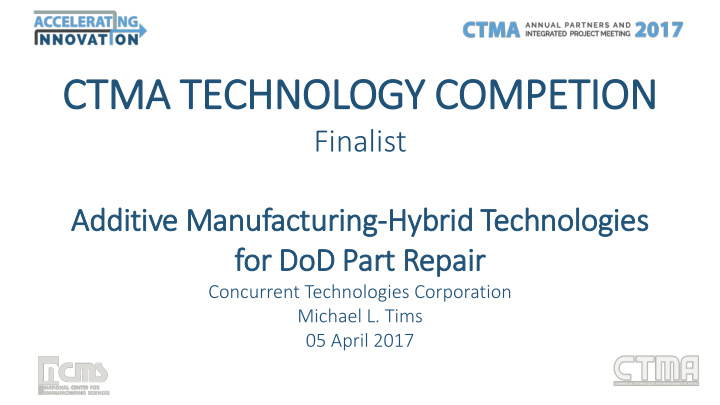



CTMA TECHNOLOGY COMPETION Finalist Additive Manufacturing-Hybrid Technologies for DoD Part Repair Concurrent Technologies Corporation Michael L. Tims 05 April 2017
Problem • Worn, deformed or broken metallic parts are often difficult to source, expensive and/or require long lead times to repair/replace – Large, single-piece parts do not lend themselves to production by powder bed additive technologies – A large number of alloys exist among military assets • Today: separate machines are used to complete various processes needed for repair; in other instances, the part is replaced • Current methods are to ground the associated asset until certified replacement part is obtained – This leads to part scavenging from the disabled asset
Solution • Hybrid directed energy deposition (DED) system – Chuck Part -> Prepare Surface -> Confirm Geometry -> Add Metal -> Machine -> Inspect -> Finished Part • Play video (on next slide) • Key participants – CTC – Hybrid Manufacturing Technologies: OEM of AMBIT™ DED hybrid AM production equipment Re-tipped – DoD entity TBD Inconel Impeller DED • Add metal alloys from commercially available powders Blade Head • Single set-up for AM and finished machining • Uses G or M code: well known in CNC community
From: https://youtu.be/CZtBQloXWh8
Benefits • Reduce repair cycle time – Build & machine in single set-up – Typical turnaround time 1 – 3 hrs/part (but part dependent) • Allows for reuse of existing parts, reducing impact to environment • Adaptable to existing CNC machine tools Inconel Flange – Limited new hardware needed Laser Marking on SS Tube – Working volume dictated by that of CNC machine tool • IN718 tensile properties & hardness comparable to wrought • Build rates: fine to 0.7 kg/hr; rapid to 2.5 kg/hr
Challenges & Risks • Metallurgical and structural integrity – Must use good process condition (laser power, speed, etc.) – Optimum process conditions yet to be determined for all alloys and geometric features of value to DoD • No qualification standards yet developed • Limited history • No DoD champion yet identified • Definition of acceptance criteria
Innovation Status • Technology has been demonstrated to MRL Level 7/8 • Most effective location for technology is at the depot repair level – Potential in-field use • Obstacles include qualification, identifying optimum process conditions for all alloys of interest Building a Boss • Outcomes include reduced orders for new parts, reduced Additions to inventory of parts Cylindrical Piece • Alternative solutions include: other forms of AM, cold spray, large part inventory, source replacements from OEMs
Vision / Final Thoughts • Using existing CNC machine tools, integrate the support hardware required for use of the system – Gas and powder metal supply – Power source for laser • Further Development Required – Qualification/Certification • In-situ inspection possible • Enhancement of technology in high-growth mode
Questions Stator Vane Section Multi-tool selection rack Material Deposition CTC’s AMBIT system in a Haas 5 -axis machining center Working volume 120″ x 40″ x 30″
Recommend
More recommend